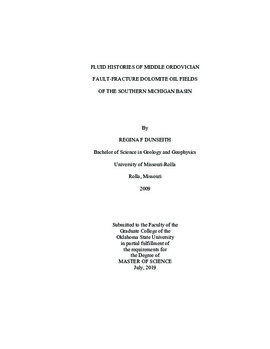| dc.contributor.advisor | Gregg, Jay M. | |
| dc.contributor.author | Dunseith, Regina F. | |
| dc.date.accessioned | 2020-01-30T19:46:36Z | |
| dc.date.available | 2020-01-30T19:46:36Z | |
| dc.date.issued | 2019-07 | |
| dc.identifier.uri | https://hdl.handle.net/11244/323389 | |
| dc.description.abstract | Fault-fracture oil fields in the Trenton and Black River formations (TBR) constitute important petroleum reservoirs in the southern Michigan Basin and are the type example for “hydrothermal” petroleum reservoirs world-wide. However, fluid histories of these oil fields are only partially understood. | |
| dc.description.abstract | Petrographic and geochemical data suggest these oil fields evolved as independent fault-controlled convective systems. Homogenization temperatures (Th) (79º C to 258º C) measured in cement inclusions indicate two fluid endmembers: a warm fluid (<180º C) and a hot fluid (>180º C). The hot fluids appear to only affect oil fields of the south-central Michigan Basin. Decreasing Th distal from the Proterozoic Mid-Michigan Rift (MMR) suggest that the hot fluids emanated from the rift area. Strontium isotope values indicate two fluid sources: Proterozoic basement and late Silurian evaporites. Values of 87Sr/86Sr for cements in the Freedom, Napoleon, Reading, and Scipio fields (0.7086-0.7088) are influenced by warm water sourced from Silurian strata, and values for cements in the Albion, Branch County, and Northville fields (0.7091 to 0.7110) record continental basement signatures. | |
| dc.description.abstract | Included fluids are saline (16.1 to 49.4 wt. % NaCl equivalent) and likely sourced from Silurian Salina Group evaporites. Eutectic temperatures (Te) (-50º C to -112º C) suggest a complex Na-Ca-KCl brine; the expected composition of dissolved Salina salts. Lower Te proximal to the MMR suggest the rift as a source of additional complexing cations | |
| dc.description.abstract | Isotope values for carbonate cements are depleted with respect to 18O (-6.59 to -12.46‰ VPDB) relative to Ordovician seawaters, and somewhat depleted with respect to 13C (-1.22 to +1.18‰ VPDB). Equilibrium calculations from 18O and Th values indicate cement precipitating waters were highly evolved (+1.3 to +14.4‰ 18OVSMOW) compared to Ordovician and Silurian seawaters (-5.5‰ 18OVSMOW). | |
| dc.description.abstract | Cement precipitating fluids in TBR oil fields likely have similar sources and timing. However, water-rock interactions along fault pathways modified source waters, giving each oil field a unique petrographic and geochemical signature. Fluids may have been shared where underlying fault systems are connected and similar cathodoluminescent cement stratigraphies are observed. Reactivation of basement faulting and fluid movement in TBR oil fields likely initiated during Silurian-Devonian tectonism. | |
| dc.format | application/pdf | |
| dc.language | en_US | |
| dc.rights | Copyright is held by the author who has granted the Oklahoma State University Library the non-exclusive right to share this material in its institutional repository. Contact Digital Library Services at lib-dls@okstate.edu or 405-744-9161 for the permission policy on the use, reproduction or distribution of this material. | |
| dc.title | Fluid Histories of Middle Ordovician Fault-Fracture Dolomite Oil Fields of the Southern Michigan Basin | |
| dc.contributor.committeeMember | Grammer, G. Michael | |
| dc.contributor.committeeMember | Pashin, Jack | |
| osu.filename | Dunseith_okstate_0664M_16335.pdf | |
| osu.accesstype | Open Access | |
| dc.type.genre | Thesis | |
| dc.type.material | Text | |
| dc.subject.keywords | dolomite | |
| dc.subject.keywords | fluid inclusion | |
| dc.subject.keywords | hydrothermal | |
| dc.subject.keywords | michigan basin | |
| dc.subject.keywords | ordovician | |
| thesis.degree.discipline | Geology | |
| thesis.degree.grantor | Oklahoma State University | |
